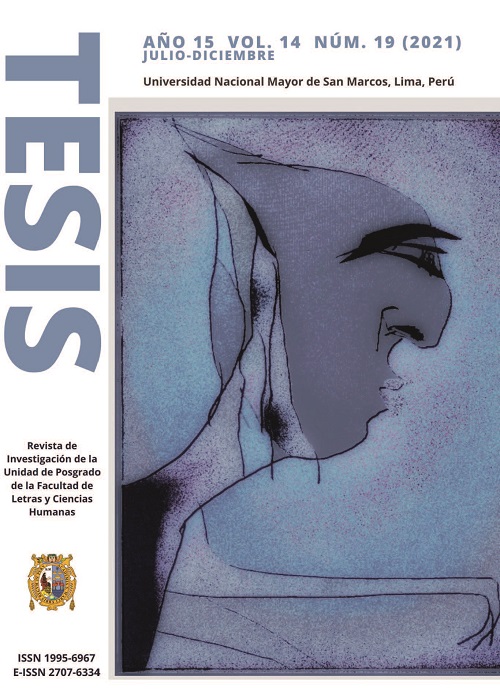Onomástica de los platos de la comida peruana desde la perspectiva de la lingüística cognitiva
DOI:
https://doi.org/10.15381/tesis.v14i19.21233Palabras clave:
léxico gastronómico, metáfora conceptual, metonimia conceptual, onomástica culinariaResumen
El objetivo de este artículo es determinar, a través del análisis de los tipos metáforas y metonimias conceptuales, los procedimientos cognitivos específicos empleados en la denominación de los platos de la comida peruana; todo ello basado en la teoría de la lingüística cognitiva. El método de investigación es cualitativo-hermenéutico de tipo análisis crítico del discurso sustentado en la teoría de la lingüística cognitiva. Los resultados muestran que los nombres de platos de la comida peruana presentan procesos metafóricos de dos tipos: metáfora única y metáforas múltiples. Asimismo, los nombres de platos de la comida peruana presentan dos procesos metonímicos: metonimia única y metonimias múltiples. También se determina la existencia de interacción entre metáfora y metonimia en el proceso de denominación de platos. La conclusión del estudio explica que el individuo al denominar los platos evidencia tres tendencias en la creación onomástica: tendencia de elección cultural, tendencia de experiencia personal y tendencia pragmática.
Referencias
Barcelona, A. (2015). Metonymy. En E. Dabrowska y D. Divjak (Eds.), Handbook of cognitive linguistics (pp. 143-167). Vol. 39, series Handbücher zur Sprach- und Kommunikationswissenschaft, Handbooks of Linguistics and Communication Science (HSK). https://doi.org/10.1515/9783110292022
Cserép, A. (2014). Conceptual metaphor theory: in defence or on the fence? Argumentum, 10, 261-288. https://dea.lib.unideb.hu/dea/bitstream/handle/2437/290792/FILE_UP_0_ cserepa.pdf?sequence=1
Denroche, C. (2014). Metonymy and language: A new theory of linguistic processing. Routledge. https://doi.org/10.4324/9781315749396
De Sousa, A. y Dargel, A. (2020). Onomástica: interdisciplinaridade e interfaces. Revista GTLex, 3(1), 7-22. https://doi.org/10.14393/Lex5-v3n1a2017-1
García, C. (2018). Deonomástica del registro coloquial y deonomástica de la lengua elaborada. En Braga, J. y García, C. (Coords.),. Deonomástica multilingüe: del nombre propio al nombre de clase (pp. 137-164). Reichenberger.
Ibarretxe-Antuñano, I. (2011). Metáforas de la percepción: Una aproximación desde la lingüística cognitiva. Recorridos de la Metáfora: Mente, espacio y diálogo. Santibáñez, C. y Osorio, J. (eds.). Concepción, Chile: Cosmigonon Ediciones, 141-166.
Ibarretxe-Antuñano, I. (2013). La lingüística cognitiva y su lugar en la historia de la lingüística. Revista Española de Lingüística Aplicada (RESLA), 26, 245-266. https://dialnet.unirioja.es/servlet/articulo?codigo=4597643
Ibarretxe-Antuñano, I. (2021). The domain of olfaction in Basque. The linguistics of olfaction. Typological and diachronic approaches to synchronic diversity, Series Typological Studies in Language, 131, 73-111. https://doi.org/10.1075/tsl.131
Kövecses, Z. (2020). An extended view of conceptual metaphor theory. Review of Cognitive Linguistics, 18(1), 112-130. https://doi.org/10.1075/rcl.18.1
Kövecses, Z. (2017). Levels of metaphor. Cognitive Linguistics, 28(2), 321-347. https://doi.org/10.1515/cog-2016-0052
Lakoff, G. (2016). Language and emotion. Emotion Review, 8(3), 269-273. https://doi.org/10.1177/1754073915595097
Loayza Maturrano, E. (2020 a). Análisis semiótico del lexicón de la comida peruana amazónica. ConCiencia EPG, 5(2), 90-109. https://doi.org/10.32654/CONCIENCIAEPG.5-2.6
Loayza Maturrano, E. (2020 b). La investigación cualitativa en Ciencias Humanas y Educación. Criterios para elaborar artículos científicos. Educare et Comunicare, 8(2), 56-66. https://doi.org/10.35383/educare.v8i2.536
Loayza Maturrano, E. (2021). Análisis lingüístico-cognitivo del discurso desde la gramática cognitiva. PURIQ, 3(2), 466-487. https://doi.org/10.37073/puriq.3.2.176
Morant, R. (2016). Denominación, alternancia onomástica y redenominación de animales domésticos. Revista de Filología Hispánica, RILCE, 32(1), 201-224. https://revistas.unav.edu/index.php/rilce/article/view/2974/2775
Reyes, M. (2021). Acercamiento onomástico al nombre de las bandas de Heavy Metal. Onomástica desde América Latina, 2(3), 59-81. https://doi.org/10.48075/odal.v0i0.26062
Rui-feng, L. (2018). Metonymy research in cognitive linguistics. Journal of Literature and Art Studies, 8(3), 445-451. https://doi.org/10.17265/2159-5836/2018.03.013
Seabra, M. e Isquerdo, A. (2018). Onomastics in different perspectives: Research results. Revista de Estudos da Linguagem, 26(3), 993-1000. http://www.periodicos.letras.ufmg.br/index.php/relin/article/view/13700/pdf
Ungerer, F. y Schmid, H. (2013). An introduction to cognitive linguistics (2nd ed.). Routledge.
Winters, M. y Nathan, G. (2020). Cognitive linguistics for linguists. Springer International Publishing. https://doi.org/10.1007/978-3-030-33604-2
Descargas
Publicado
Número
Sección
Licencia
Derechos de autor 2021 Edward Faustino Loayza-Maturrano

Esta obra está bajo una licencia internacional Creative Commons Atribución 4.0.
LOS AUTORES RETIENEN SUS DERECHOS:
a. Los autores retienen sus derechos de marca y patente, y también sobre cualquier proceso o procedimiento descrito en el artículo.
b. Los autores retienen el derecho de compartir, copiar, distribuir, ejecutar y comunicar públicamente el artículo publicado en la revista Tesis (Lima) (por ejemplo, colocarlo en un repositorio institucional o publicarlo en un libro), con un reconocimiento de su publicación inicial en la revista Tesis (Lima).
c. Los autores retienen el derecho a hacer una posterior publicación de su trabajo, de utilizar el artículo o cualquier parte de aquel (por ejemplo: una compilación de sus trabajos, notas para conferencias, tesis, o para un libro), siempre que indiquen la fuente de publicación (autores del trabajo, revista, volumen, numero y fecha).






